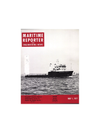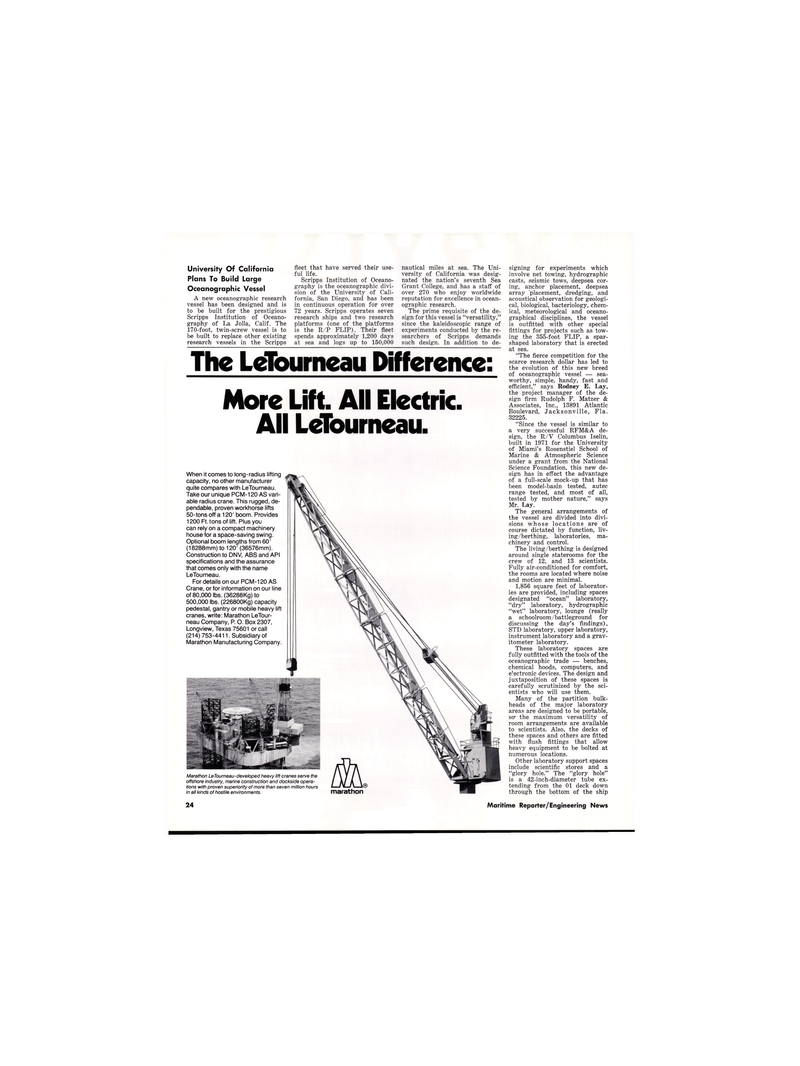
Page 22: of Maritime Reporter Magazine (May 1977)
Read this page in Pdf, Flash or Html5 edition of May 1977 Maritime Reporter Magazine
University Of California
Plans To Build Large
Oceanographic Vessel
A new oceanographic research vessel has been designed and is to be built for the prestigious
Scripps Institution of Oceano- graphy of La Jolla, Calif. The 170-foot, twin-screw vessel is to be built to replace other existing research vessels in the Scripps fleet that have served their use- ful life.
Scripps Institution of Oceano- graphy is the oceanographic divi- sion of the University of Cali- fornia, San Diego, and has been in continuous operation for over 72 years. Scripps operates seven research ships and two research platforms (one of the platforms is the R/P FLIP). Their fleet spends approximately 1,200 days at sea and logs up to 150,000 nautical miles at sea. The Uni- versity of California was desig- nated the nation's seventh Sea
Grant College, and has a staff of over 270 who enjoy worldwide reputation for excellence in ocean- ographic research.
The prime requisite of the de- sign for this vessel is "versatility," since the kaleidoscopic range of experiments conducted by the re- searchers of Scripps demands such design. In addition to de- signing for experiments which involve net towing, hydrographic casts, seismic tows, deepsea cor- ing, anchor placement, deepsea array placement, dredging, and acoustical observation for geologi- cal, biological, bacteriology, chem- ical, meteorological and oceano- graphical disciplines, the vessel is outfitted with other special fittings for projects such as tow- ing the 355-foot FLIP, a spar- shaped laboratory that is erected at sea. "The fierce competition for the scarce research dollar has led to the evolution of this new breed of oceanographic vessel — sea- worthy, simple, handy, fast and efficient," says Rodney E. Lay, the project manager of the de- sign firm Rudolph F. Matzer &
Associates, Inc., 13891 Atlantic
Boulevard, Jacksonville, Fla. 32225. "Since the vessel is similar to a very successful RFM&A de- sign, the R/V Columbus Iselin, built in 1971 for the University of Miami's Rosenstiel School of
Marine & Atmospheric Science under a grant from the National
Science Foundation, this new de- sign has in effect the advantage of a full-scale mock-up that has been model-basin tested, autec range tested, and most of all, tested by mother nature," says
Mr. Lay.
The general arrangements of the vessel are divided into divi- sions whose locations are of course dictated by function, liv- ing/berthing, laboratories, ma- chinery and control.
The living/berthing is designed around single staterooms for the crew of 12, and 13 scientists.
Fully air-conditioned for comfort, the rooms are located where noise and motion are minimal. 1,856 square feet of laborator- ies are provided, including spaces designated "ocean" laboratory, "dry" laboratory, hydrographic "wet" laboratory, lounge (really a schoolroom/battleground for discussing the day's findings),
STD laboratory, upper laboratory, instrument laboratory and a grav- itometer laboratory.
These laboratory spaces are fully outfitted with the tools of the oceanographic trade — benches, chemical hoods, computers, and e'ectronic devices. The design and juxtaposition of these spaces is carefully scrutinized by the sci- entists who will use them.
Many of the partition bulk- heads of the major laboratory areas are designed to be portable, so- the maximum versatility of room arrangements are available to scientists. Also, the decks of these spaces and others are fitted with flush fittings that allow heavy equipment to be bolted at numerous locations.
Other laboratory support spaces include scientific stores and a "glory hole." The "glory hole" is a 42-inch-diameter tube ex- tending from the 01 deck down through the bottom of the ship
The LcTourncau Difference:
More Lift. All Electric. All LeTourneau.
Marathon LeTourneau-developed heavy lift cranes serve the offshore industry, marine construction and dockside opera- tions with proven superiority of more than seven million hours in all kinds of hostile environments. marathon
When it comes to long-radius lifting capacity, no other manufacturer quite compares with LeTourneau.
Take our unique PCM-120 AS vari- able radius crane. This rugged, de- pendable, proven workhorse lifts 50-tons off a 120' boom. Provides 1200 Ft. tons of lift. Plus you can rely on a compact machinery house for a space-saving swing.
Optional boom lengths from 60' (18288mm) to 120' (36576mm).
Construction to DNV, ABS and API specifications and the assurance that comes only with the name
LeTourneau.
For details on our PCM-120 AS
Crane, or for information on our line of 80,000 lbs. (36288Kg) to 500,000 lbs. (226800Kg) capacity pedestal, gantry or mobile heavy lift cranes, write: Marathon LeTour- neau Company, P. O. Box 2307,
Longview, Texas 75601 or call (214) 753-4411. Subsidiary of
Marathon Manufacturing Company. 24 Maritime Reporter/Engineering News

 21
21

 23
23
